|
Infrared light is
even used to heat food sometimes - special lamps that emit thermal
infrared waves are often used in fast food restaurants!
|
Shorter, near infrared waves are not hot at all - in fact
you cannot even feel them. These shorter wavelengths are the
ones used by your TV's remote control. |
 |
How can we "see"
using the Infrared?
Since the primary
source of infrared radiation is heat or thermal radiation, any
object which has a temperature radiates in the infrared. Even
objects that we think of as being very cold, such as an ice cube,
emit infrared. When an object is not quite hot enough to radiate
visible light, it will emit most of its energy in the infrared.
For example, hot charcoal may not give off light but it does emit
infrared radiation which we feel as heat. The warmer the object,
the more infrared radiation it emits.
|
Humans, at normal body temperature, radiate most strongly in
the infrared at a wavelength of about 10 microns. (A micron
is the term commonly used in astronomy for a micrometer or
one millionth of a meter.) This image ( which is courtesy of
the Infrared Processing and Analysis Center at CalTech),
shows a man holding up a lighted match! Which parts of this
image do you think have the warmest temperature? How does
the temperature of this man's glasses compare to the
temperature of his hand? |
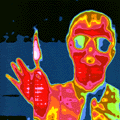
 |
 |
To make infrared pictures like the one above, we can use
special cameras and film that detect differences in
temperature, and then assign different brightness or false
colors to them. This provides a picture that our eyes can
interpret.
The image
at the left (courtesy of SE-IR Corporation, Goleta, CA)
shows a cat in the infrared. The orange areas are the
warmest and the white-blue areas are the coldest. This
image gives us a different view of a familiar animal as
well as information that we could not get from a visible
light picture.
|
Humans may not be
able to see infrared light, but did you know that snakes in the
pit viper family, like rattlesnakes, have sensory "pits", which
are used to image infrared light? This allows the snake to detect
warm blooded animals, even in dark burrows! Snakes with 2 sensory
pits are even thought to have some depth perception in the
infrared! (Thanks to NASA's Infrared Processing and Analysis
Center for help with the text in this section.)
Many things besides
people and animals emit infrared light - the Earth, the Sun, and
far away things like stars and galaxies do also! For a view from
Earth orbit, whether we are looking out into space or down at
Earth, we can use instruments on board satellites.
|
Satellites like GOES 6 and Landsat 7 look at the Earth.
Special sensors, like those aboard the Landsat 7 satellite,
record data about the amount of infrared light reflected or
emitted from the Earth's surface. |
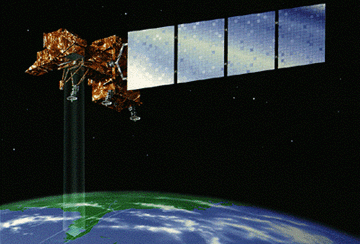
Landsat 7 |
Other satellites,
like the Infrared Astronomy Satellite (IRAS) look up into space
and measure the infrared light coming from things like large
clouds of dust and gas, stars, and galaxies!
What does the
Infrared show us?
|
This is an infrared image of the Earth taken by the GOES 6
satellite in 1986. A scientist used temperatures to
determine which parts of the image were from clouds and
which were land and sea. Based on these temperature
differences, he colored each separately using 256 colors,
giving the image a realistic appearance.
Why use the
infrared to image the Earth? While it is easier to
distinguish clouds from land in the visible range, there
is more detail in the clouds in the infrared. This is
great for studying cloud structure. For instance, note
that darker clouds are warmer, while lighter clouds are
cooler. Southeast of the Galapagos, just west of the coast
of South America, there is a place where you can
distinctly see multiple layers of clouds, with the warmer
clouds at lower altitudes, closer to the ocean that's
warming them.
|
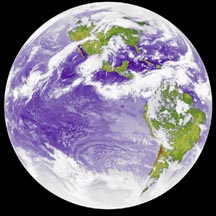

Space Science and Engineering Center,
University of Wisconsin-Madison,
Richard Kohrs, designer |
We know, from
looking at an infrared image of a cat, that many things emit
infrared light. But many things also reflect infrared light,
particularly near infrared light. Near infrared radiation is not
related to the temperature of the object being photographed -
unless the object is very, very hot.
Infrared film
'sees' the object because the Sun (or some other light source)
shines infrared light on it and it is reflected or absorbed by the
object. You could say that this reflecting or absorbing of
infrared helps to determine the object's 'color' - its color being
a combination of red, green, blue, and infrared!
|
This image
of a building with a tree and grass shows how Chlorophyll
in plants reflect near infrared waves along with visible
light waves. Even though we can't see the infrared waves,
they are always there. The visible light waves drawn on
this picture are green, and the infrared ones are pale
red.
|
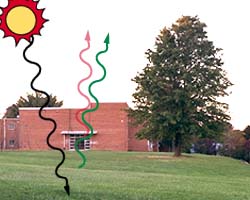 |
|
This image was taken with special film that can detect
invisible infrared waves. This is a false-color image, just
like the one of the cat. False-color infrared images of the
Earth frequently use a color scheme like the one shown here,
where infrared light is mapped to the visible color of red.
This means that everything in this image that appears red is
giving off or reflecting infrared light. This makes
vegetation like grasa and trees appear to be red. The
visible light waves drawn on this picture are green, and the
infrared ones are darker red. |
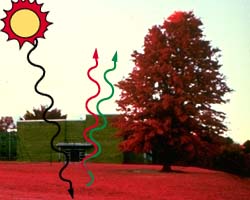 |
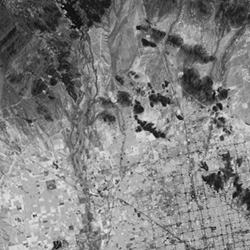
 |
This is an image of Phoenix, Arizona showing the near
infrared data collected by the Landsat 5 satellite. The
light areas are areas with high reflectance of near infrared
waves. The dark areas show little reflectance. What do you
think the black grid lines in the lower right of this image
represent? |
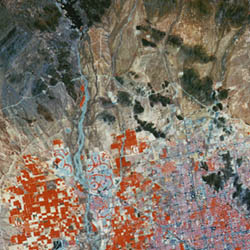
 |
This image shows the infrared data (appearing as red)
composited with visible light data at the blue and green
wavelengths. If near infrared is reflected off of healthy
vegetation, what do you think the red square shaped areas
are in the lower left of the image? |
Instruments on
board satellites can also take pictures of things in space. The
image below of the center region of our galaxy was taken by IRAS.
The hazy, horizontal S-shaped feature that crosses the image is
faint heat emitted by dust in the plane of the Solar System.
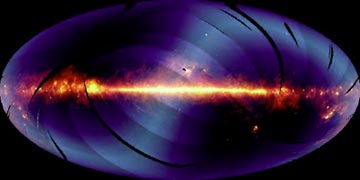 
Infrared Processing and Analysis Center, Caltech/JPL |

